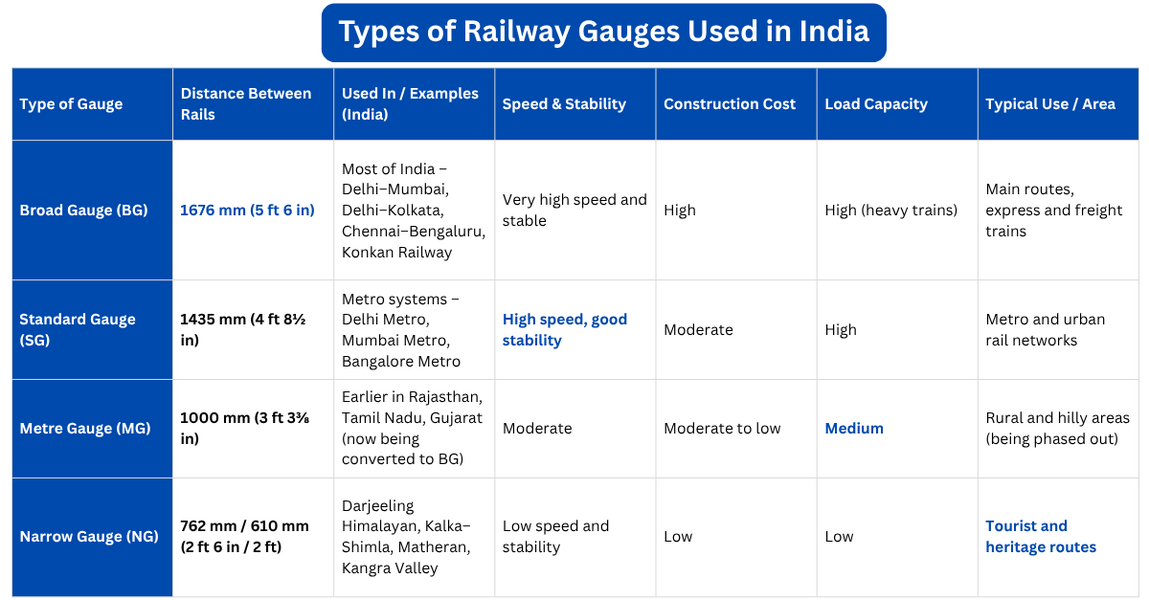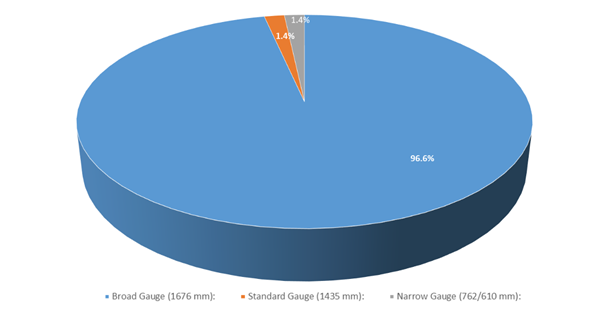Railway gauges form the foundation of India’s rail network.
The word "gauge" merely means the distance between the inner sides of two rails.
Because India’s geography and terrain vary so widely, different gauges were originally used to balance factors like cost, speed, and regional needs.
Let's take a closer look at each type and how the railway system of India has evolved over time.

In India, it is adopted mainly for metro rail systems such as:
These tracks can still be seen on iconic heritage railways such as:
Main Reasons for Conversion all tracks to Broad Gauge :
From the colonial mixture of gauges to a single, modern Broad Gauge network, India's railways have evolved. While it brings faster, safer, and more efficient rail transport, it also strengthens national connectivity. Continuous surveys, scientific testing, and modernization undertaken by the Indian Railways have put it on course to become a world-class transport system: one that is reliable, strong, and future-ready.
The word "gauge" merely means the distance between the inner sides of two rails.
Because India’s geography and terrain vary so widely, different gauges were originally used to balance factors like cost, speed, and regional needs.
Let's take a closer look at each type and how the railway system of India has evolved over time.

Broad Gauge (BG) – 1676 mm (5 ft 6 in)
- Broad Gauge: This is the widest and most commonly used railway gauge in India; it is now the national standard.
- It was the first gauge introduced in 1853 for the first rail line of India between Mumbai and Thane.
- It covers more than 96% of the Indian Railway network today, connecting major routes like Delhi–Mumbai, Delhi–Kolkata, Chennai–Bengaluru, and the scenic Konkan Railway.
Key Features of Broad Gauge :
- Ensures high stability and smoother rides, even at greater speeds.
- It can carry heavier and longer trains, very suitable for passenger and freight traffic.
- Works well on curved or rough surfaces.
Challenges of Broad Gauge :
- Construction and maintenance costs are relatively higher due to its size.
- Use: Primarily on main routes, express trains, and freight corridors.
Standard Gauge (SG) – 1435 mm (4 ft 8½ in)
The Standard Gauge is the global benchmark, used extensively in countries like the USA, Japan, China, and across Europe.In India, it is adopted mainly for metro rail systems such as:
- Delhi Metro (Phases I & II)
- Mumbai Metro
- Bangalore Metro
- Hyderabad and Jaipur Metro
Key Features of Standard Gauge:
- Designed for urban and high-speed transit.
- Provides smooth rides and excellent stability for traveling short distances.
Standard Gauge Challenges:
- Not compatible with India’s existing Broad Gauge network, hence used only for city metros.
- Urban metro systems and rapid transit networks.
- Metre Gauge (MG) – 1000 mm (3 ft 3⅜ in)
- During the British period, the Metre Gauge came into use in order to make the construction of rails cheaper in less-developed regions.
- Once widespread in Rajasthan, Tamil Nadu, Gujarat, and parts of Uttar Pradesh.
Narrow Gauge (NG) – 762 mm (2 ft 6 in) / 610 mm (2 ft)
Narrow Gauge: The narrow gauge is the smallest of all and was introduced for mountainous and tourist routes.These tracks can still be seen on iconic heritage railways such as:
- Darjeeling Himalayan Railway (610 mm)
- Kalka–Shimla Railway (762 mm)
- Matheran Hill Railway (610 mm)
- Kangra Valley Railway (762 mm)
Key Features of Narrow Gauge:
- Easier and cheaper to construct in difficult mountain terrains.
- Requires less space and lower investment.
Challenges of Narrow Gauge:
- It allows only slow speeds and lighter loads.
- Needs frequent maintenance and offers less stability.
- Use: Limited to heritage and tourist trains.
- Current Status: Most routes are being phased out or preserved as UNESCO World Heritage Lines.
Why India is Converting All Tracks to Broad Gauge!
The Indian government launched the Project Unigauge to modernize its railway system by converting all metre and narrow gauge lines into Broad Gauge.Main Reasons for Conversion all tracks to Broad Gauge :
- Uniform Network : enables the smooth passage of trains throughout the country.
- Higher Speed & Safety : Broad Gauge is more stable and supports faster operations.
- Heavy Load Capacity : Suitable for longer, heavier trains carrying freight and passengers.
- Easier Electrification : Compatible with modern electrification systems.
- Reduced Maintenance Costs : Standardization simplifies spare parts and upkeep.
Surveys and Testing Before Construction or Upgrading
Before laying or upgrading railway tracks, detailed surveys and technical tests are done by engineers to ensure safety and durability.Types of Surveys
- Reconnaissance Survey: Early-stage route exploration using GPS, drones, and maps.
- Preliminary Survey: Compares possible routes, checking soil quality and estimating cost.
- Final Location Survey: Determines the final alignment using Total Station and GPS tools.
- Geotechnical & Hydrological Surveys: Tests soil strength, drainage patterns, and water flow behavior.
- Common Instruments Used: Total Station, GPS, Auto Level, Theodolite, Core Drilling Machine, Soil Testing Kit, and Rain Gauge.
Tests During Construction and Upgradation Soil Tests:
- To check compaction, bearing capacity, and moisture levels.
- Ballast Tests: Assess the quality and durability of the stone bed under rails.
- Sleeper tests: For checking dimensional accuracy and strength.
- Rail Tests: USFD - ultrasonic flaw detection for cracks and other metal defects.
- Track Geometry Tests: Measure alignment, cross levels, and gauge accuracy.
- Speed Trials: These are held before tracks are opened to the public.
From the colonial mixture of gauges to a single, modern Broad Gauge network, India's railways have evolved. While it brings faster, safer, and more efficient rail transport, it also strengthens national connectivity. Continuous surveys, scientific testing, and modernization undertaken by the Indian Railways have put it on course to become a world-class transport system: one that is reliable, strong, and future-ready.
